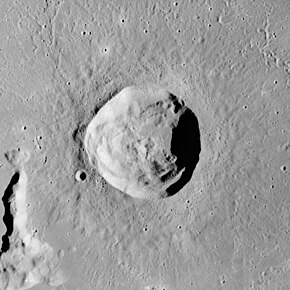Delisleis a smalllunarimpact craterin the western part of theMare Imbrium.It was named after French astronomerJoseph-Nicolas Delisle.[1]It lies to the north of the craterDiophantus,and just to the northwest of the ridge designatedMons Delisle.Between Delisle and Diophantus is a sinuousrillenamed Rima Diophantus, with a diameter of 150 km. To the northeast is another rille designated Rima Delisle, named after this crater.
 Apollo 15image | |
| Coordinates | 29°54′N34°36′W/ 29.9°N 34.6°W |
|---|---|
| Diameter | 25 km |
| Depth | 2.6 km |
| Colongitude | 35° at sunrise |
| Eponym | Joseph-Nicolas Delisle |


The rim of Delisle is somewhatpolygonalin form and it has a low central rise on the floor. There is some slight slumping along the inner wall, but overall the rim is still relatively fresh with little appearance of significant wear. The outer rim is surrounded by a small rampart of hummocky terrain.
Delisle is a crater ofEratosthenianage.[2]
This formation has also been designated "De l'Isle" in some sources.
Rima Delisle
editThis is a sinuous rille centered on selenographic coordinates 31.0° N, 32.0° W. It occupies a maximum diameter of 60 km. Three tiny craters in the vicinity of this feature have been assigned names by theIAU.These are listed in the table below.
| Crater | Longitude | Latitude | Diameter | Name source |
|---|---|---|---|---|
| Boris | 30.6° N | 33.5° W | 4 km | Russianmasculine name |
| Gaston | 30.9° N | 34.0° W | 2 km | Frenchmasculine name |
| Linda | 30.7° N | 33.4° W | 1 km | Spanishfeminine name |
Satellite craters
editBy convention these features are identified on lunar maps by placing the letter on the side of the crater midpoint that is closest to Delisle.
| Delisle | Latitude | Longitude | Diameter |
|---|---|---|---|
| K | 29.0° N | 38.4° W | 3 km |
References
edit- ^"Delisle (crater)".Gazetteer of Planetary Nomenclature.USGS Astrogeology Research Program.
- ^The geologic history of the Moon.USGSProfessional Paper 1348. ByDon E. Wilhelms,John F. McCauley, and Newell J. Trask. U.S. Government Printing Office, Washington: 1987. Table 12.2.
- Andersson, L. E.;Whitaker, E. A.(1982).NASACatalogue of Lunar Nomenclature.NASA RP-1097.
- Bussey, B.;Spudis, P.(2004).The Clementine Atlas of the Moon.New York:Cambridge University Press.ISBN978-0-521-81528-4.
- Cocks, Elijah E.; Cocks, Josiah C. (1995).Who's Who on the Moon: A Biographical Dictionary of Lunar Nomenclature.Tudor Publishers.ISBN978-0-936389-27-1.
- McDowell, Jonathan (July 15, 2007)."Lunar Nomenclature".Jonathan's Space Report.Retrieved2007-10-24.
- Menzel, D. H.; Minnaert, M.; Levin, B.; Dollfus, A.; Bell, B. (1971). "Report on Lunar Nomenclature by the Working Group of Commission 17 of the IAU".Space Science Reviews.12(2): 136–186.Bibcode:1971SSRv...12..136M.doi:10.1007/BF00171763.S2CID122125855.
- Moore, Patrick(2001).On the Moon.Sterling Publishing Co.ISBN978-0-304-35469-6.
- Price, Fred W. (1988).The Moon Observer's Handbook.Cambridge University Press.ISBN978-0-521-33500-3.
- Rükl, Antonín(1990).Atlas of the Moon.Kalmbach Books.ISBN978-0-913135-17-4.
- Webb, Rev. T. W.(1962).Celestial Objects for Common Telescopes(6th revised ed.). Dover.ISBN978-0-486-20917-3.
- Whitaker, Ewen A.(1999).Mapping and Naming the Moon.Cambridge University Press.ISBN978-0-521-62248-6.
- Wlasuk, Peter T. (2000).Observing the Moon.Springer.ISBN978-1-85233-193-1.